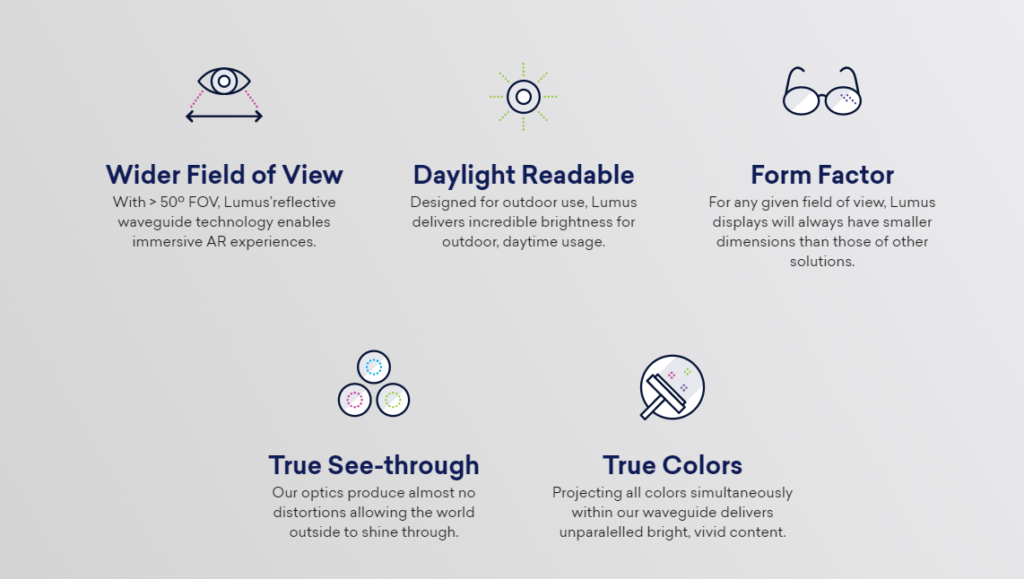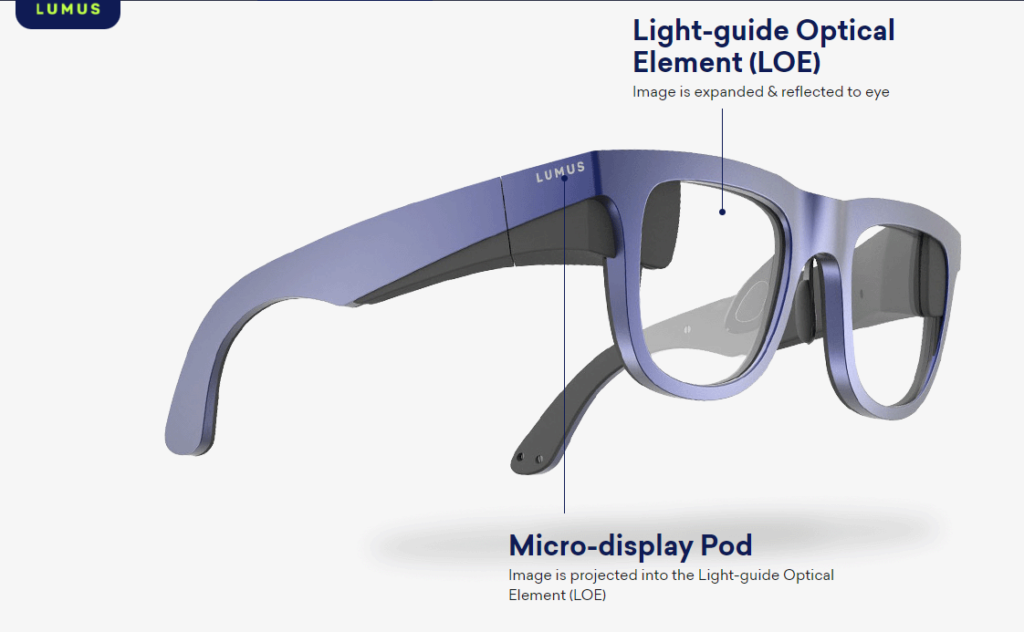Lumus, an Israeli augmented reality (AR) optics company that specialises in reflective 2D waveguide technology, has launched the latest generation of its display architecture.

Lumus reflective waveguides used in the 2D Maximus design, the second generation Z-Lens can deliver a 3,000-nit display at 2K-by-2K resolution in an optical engine that’s 50% smaller and could weigh as little as 50 grams (in a monocular design). This makes it possible to manufacture stylish, lightweight AR glasses without any tradeoffs, such as tinting the lens or frequent charging.

Press release – Lumus
Lumus Launches Next Generation 2D ‘Z-Lens’ Waveguide Architecture: Removing Key Obstacles to Consumer Augmented Reality Glasses
Z-Lens retains all of the performance advantages of the original Maximus 2D architecture while shrinking the projector module by more than 50%.
NESS ZIONA, Israel, Jan. 5, 2023 /PRNewswire/ — Lumus, the pioneering developer of reflective waveguide technology for augmented reality (AR) eyewear, today announced the introduction of its 2nd generation Z-Lens 2D waveguide architecture that builds upon 2D Maximus to enable the development of smaller, lighter AR eyeglasses with high-resolution image quality, outdoor-compatible brightness and seamless Rx integration. The new technology will be demoed publicly for the first time at CES 2023.
Lumus Z-Lens 2D waveguide architecture
Lumus Z-Lens 2D waveguide architecture
“In order for AR glasses to penetrate the consumer market in a meaningful way, they need to be impressive both functionally and aesthetically. With Z-Lens, we’re aligning form and function, eliminating barriers-of-entry for the industry and paving the way for widespread consumer adoption,” said Lumus CEO Ari Grobman. “Our introduction of Maximus 2D reflective waveguide technology two years ago was just the beginning. Z-Lens, with all of its improvements unlocks the future of augmented reality that consumers are eagerly waiting for.”
Big functionality, small form factor
Lumus’ new Z-Lens waveguide architecture maintains the superb image quality and high luminance efficiency advantages of its predecessor, Maximus, but features an optical engine that is 50% smaller. The new architecture also allows for more flexibility for glasses manufacturers to place the entrance aperture in various positions. This allows for significantly more compact AR optics for natural looking glasses that reduce the weight and bulk associated with many of today’s solutions.
Z-Lens’ new, lightweight optical engine features 2K x 2K resolution and full, vibrant color to offer superb image quality. With a brightness of 3,000 nits/Watt, consumers will be able to enjoy augmented reality in daylight through a pair of glasses that – from the outside – are virtually indistinguishable from a non-AR pair.
Lumus’ Z-Lens architecture also allows for direct bonding of optical elements for Rx prescription glasses, which can be licensed and utilized by manufacturing partners. This feature allows consumers to customize their AR eyeglasses to their vision without bulky, heavy inserts, enabling them to be utilized as normal eyewear.
“AR experts call the face a ‘sacred space’ – and it’s quite true. Natural-looking glasses with augmented reality functionality will unlock the consumer market and propel the industry forward,” Grobman emphasized. “Manufacturers will need to create aesthetically-appealing glasses before mass adoption can ever become a reality, and Z-Lens allows them to do exactly this.”
The new bonding feature within Z-Lens also allows for dynamic focal lens integration that helps solve vergence-accommodation conflict (VAC), a visual phenomenon that occurs when the brain receives mismatching cues between vergence and accommodation of the eye.
Critical to a positive user-experience, Z-Lens also eliminates ambient light artifacts on the lenses – a common effect in AR glasses where small glares of light hit the optical display elements when the displays are turned off. And, like the original Maximus, Z-Lens architecture prioritizes privacy by eliminating light leakage, meaning third parties are absolutely not able to see what the AR wearer is viewing.
In a pair of AR glasses, lenses that utilize Z-Lens reflective waveguides will function as the ‘screen’ on which content is displayed, originating from any of a variety of micro-display technologies including microLED, LCoS or laser based micro-projectors, integrated into the top perimeter corner of each lens cutout.
All Lumus reflective waveguides contain a series of ‘cascading’ partially reflective mirrors that guide the signal through the waveguide into the viewer’s eye. These transflective, partial mirrors expand the image along both the “X” and “Y” axes, expanding the image vertically and horizontally. This 2D expansion architecture enables a large field of view, while maintaining a tiny projector discreetly hidden in the temple of the eyeglass frame.
The first prototypes of Lumus Z-Lens will feature a 50-degree field of view, however the company has a product roadmap reaching greater than 80 degrees. Z-Lens can be integrated into finished products that appear virtually identical to standard eyeglasses.
The future is looking up
According to Grobman, Lumus’ Z-Lens architecture will play an outsized role in advancing the AR eyeglass market – a category that is at the threshold of rapid growth.
“AR glasses are poised to transform our society,” he said. “They feature better ergonomics than smartphones, novel interaction opportunities with various environments and businesses, and a much more seamless experience than handheld devices. The future, quite literally, is looking up.”
Lumus holds more than 430 patents, with more than 540 additional patents pending, placing it among the world’s top patent holders for augmented reality optics.
For high-res imagery, click here.
About Lumus
Lumus reflective waveguides set an industry benchmark for AR image quality. Far brighter than other solutions, Lumus is the only waveguide ideally suited for outdoor usage. With up to 10X better luminance efficiency over competing waveguides and supply chain partners like Quanta and SCHOTT, Lumus is the leading choice for OEMs making AR glasses. Lumus waveguide technology provides unparalleled color uniformity and a true white due to the straight-forward light path inherent in its architecture.
Other key advantages: a smaller micro-projector, a large field of view, and a distortion-free view of the real world. Remarkably, battery efficiency is up to 10 times greater than any other waveguide on the market, and forward light leakage (forward projection) is negligible.
Lumus co-developed manufacturing processes with its world class supply chain partners including Quanta Computer Inc. and SCHOTT, to achieve scalability for mass manufacturing. The company is the leading designer of reflective waveguide technology at the core of several existing AR products including Thales’ Scorpion full-color head mounted display, Augmedics xVision system for guiding surgeons, Lenovo’s ThinkReality A6 released in 2019 as well as Thirdeye’s X2 MR Glasses.

SOURCE Lumus
